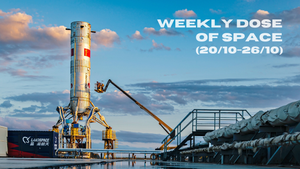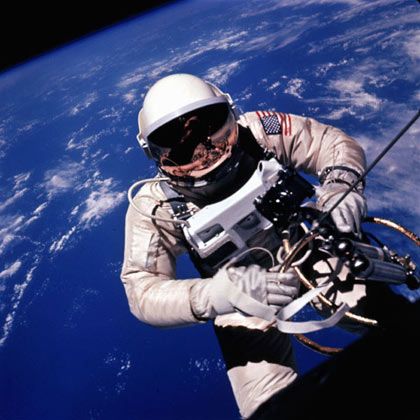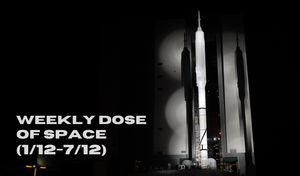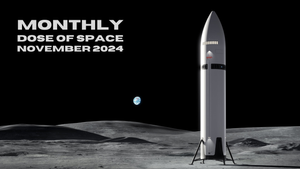
Weekly Dose of Space (20/10-26/10)
Welcome back to Weekly Dose of Space! This week had eight orbital launches occur, with the majority carrying Starlink satellites. News this week had Shenzhou-19 prepped for launch, Blue Origin moving ever closer to New Glenn's first flight, and Boeing potentially leaving the space business. As always, we'll also look ahead to what the worldwide launch schedule might look like next week.
SpaceX
This week at Starbase began on October 22nd out in the Gulf of Mexico when SpaceX was spotted recovering Booster 12's hot staging ring, as it had jettisoned it ahead of being caught for flight five. Not long after, Booster 13 was rolled out to the launch site to undergo testing ahead of flight six of Starship-Super Heavy.

Late on October 22nd, Booster 13 was lifted onto the Orbital Launch Mount by the launch towers 'chopsticks'.
Two days later on October 24th, Booster 13 underwent a propellant loading test, followed by propellant unloading a little later. Near sunset propellant was flowed back into the booster and it performed a static fire, presumably with all thirty-three of its Raptor engines.
STATIC FIRE! Booster 13 fires up ahead of Flight 6 of Starship. Its partner, Ship 31, has already been Static Fired.
— Chris Bergin - NSF (@NASASpaceflight) October 25, 2024
This has happened less than two weeks after Flight 5.
Live on X and YT: https://t.co/JYgUHWAJm7 pic.twitter.com/5lmDfRnL49
Booster 13's static fire on October 24th, via NASASpaceflight on X.
The day after performing a static fire, Booster 13 was moved off of the Orbital Launch Mount and rolled back to the production site.
Launches This Week
October 19th - Falcon 9 with Starlink Group 8-19
SpaceX delivered a batch of twenty Starlink satellites to low Earth orbit atop of a Falcon 9 from Space Launch Complex 40, in Florida. The booster for thus mission was B1076 making its seventeenth flight, and landing downrange on the drone ship 'Just Read The Instructions'.

This launch occurred very late last week and was not included in the previous Weekly Dose of Space.
October 20th - Falcon 9 with OneWeb 20
Another Falcon 9 lifted off from Space Launch Complex 4E, in California, carrying twenty internet satellites into a polar orbit for OneWeb. Supporting this mission was booster B1082, flying for the seventh time, and landing back at Landing Zone 4.

October 22nd - Long March 6 with Tianping-3
A Long March 6 lifted off from Launch Complex 16 at the Taiyuan Satellite Launch Center carrying three Tianping-3 satellites to sun-synchronous orbit. The Tianping-3 satellites are expected to provide space environment surveys, orbital prediction model corrections, supporting imaging tests for ground optical equipment, and detection and monitoring tests of the low Earth orbit environment.

October 23rd - Long March 2C with Yaogan-43 Group 03
A Long March 2C blasted off from Launch Complex 3 at the Xichang Satellite Launch Center carrying three satellites for Group 03 of the Yaogan-43 constellation into low Earth orbit. The Yaogan-43 satellites are expected to test technologies for low Earth orbit constellations along with providing data for land surveying, disaster prevention, and monitoring of the Earth below as remote sensing satellites.

October 23rd - New Shepard with NS-27
Blue Origin completed a suborbital flight of New Shepard with a brand new booster and capsule ahead of flying passengers above the Kármán line. This mission also carried twelve payloads onboard instead of passengers. Seven of these payloads were in the capsule while five were on the booster.
Booster touchdown. #NS27 pic.twitter.com/f3xcljjrVR
— Blue Origin (@blueorigin) October 23, 2024
Blue Origin's New Shepard booster landing in Texas during the NS-27 mission, via Blue Origin on X.
October 23rd - Falcon 9 with Starlink Group 6-61
Falcon 9 delivered another twenty-three Starlink satellites to low Earth orbit from Space Launch Complex 40. The booster for this mission for B1073, on its eighteenth flight, and landing on the drone ship 'A Shortfall of Gravitas' downrange.

October 24th - Falcon 9 with NROL-167
Falcon 9 launched the NROL-167 mission, likely carrying a batch of Starshield satellites, into an undisclosed orbit. Booster B1063 was supporting this mission, flying for the twenty-first time, and landed on the drop ship 'Of Course I Still Love You' downrange.

October 26th - Falcon 9 with Starlink Group 10-8
Twenty-two more Starlink satellites were delivered to low Earth orbit atop of a Falcon 9 flying from Space Launch Complex 40. This mission's booster was B1069, making its nineteenth flight, and landing on the drone ship 'Just Read The Instructions' downrange.

In Other Space News
Shenzhou-19 spacecraft rolled out for launch

China's next crewed mission to its Tiangong Space Station, Shenzhou-19, had its spacecraft and launch vehicle, a Long March 2F/G, moved to the launchpad at the Jiuquan Satellite Launch Center on October 22nd.
Now at the launch pad, the Shenzhou-19 spacecraft and Long March 2F/G launch vehicle will undergo final testing and launch rehearsals. The launch site and facilities are reportedly in good condition ahead of launch, according to the China Manned Space Agency.
Launch of the Shenzhou-19 mission is currently expected as soon as October 29th. The crew for the mission has not yet been announced by the China Manned Space Agency, as is tradition in China.
Once at the Tiangong Space Station, the Shenzhou-19 will take over the Shenzhou-18 crew's duties and stay aboard the station for approximately six months. The current crew aboard the station are Ye Guangfu (叶光富), Li Cong (李聪), and Li Guangsu (李广苏).
Blue Origin completes New Glenn engine installation

Blue Origin announced on October 24th that it had completed engine installation on New Glenn's first-stage. Seven BE-4 engines are now installed on the vehicle, to generate a combined thrust of 1744 tons at liftoff. Dave Limp, Blue Origin's Chief Executive Officer, said the following after engine installation:
"Great job by the engineering, operations and engine teams on the installation. The seven BE-4 engines in this image will deliver more than 3.8 million pounds of thrust for New Glenn. Three of the seven engines gimbal to provide the control authority for New Glenn during ascent, re-entry, and landing on Jacklyn, our recovery vessel downrange at sea. That gimbal capability, along with the landing gear and Reaction Control System thrusters, are key to making our booster fully reusable."
With all seven engines now installed, Blue Origin is expecting to conduct a static fire of the stage at its launch pad, Launch Complex 36 in Florida. Following a successful static fire, New Glenn's first flight is expected to occur in November.
Boeing possibly looking to exit space
Initially reported by the Wall Street Journal on October 25th, Boeing is possibly looking to sell its space division. This division manages International Space Station operations, the Starliner spacecraft, the highly secretive X-37B spaceplane, and the core stage of NASA's Space Launch System rocket to name a few.
The move to possibly sell the company's space business is reportedly a move by Boeing's new Chief Executive Officer, Kelly Ortberg, to cut costs and simplify the company's portfolio. Boeing's defense and space division has already lost 3.1 billion United States Dollars in the first three quarters of 2024. Total losses on the Starliner spacecraft have also reached 1.85 billion Dollars.
Boeing has also disliked the U.S. government's move to fixed-price contracts in recent years, meaning that the company, and not the government, would absorb cost overruns. One of the company's most lucrative contracts is its cost-plus contract, meaning the government is on the hook for cost overruns, for NASA's Space Launch System's core stage. This contract pushes the vehicle's cost per launch to 2.2 billion Dollars, and 4.1 billion Dollars once the Orion spacecraft, its service module, and ground system costs are accounted for.
What to Expect Next Week
Starbase
SpaceX is yet to reveal when it is targeting the next flight of Starship-Super Heavy. The license for the previous flight does allow for another test flight, so long as no major alterations are made to the flight plan. Ship 31 and Super Heavy Booster 13 have already performed static fire and propellant loading tests. The final major hardware milestones ahead of the next flight are believed to be combined testing of the two vehicles and installation of flight termination explosives.
October 29th - Falcon 9 with Starlink Group 9-9
A Falcon 9 is expected to launch from Space Launch Complex 4E carrying a batch of Starlink satellites to low Earth orbit.
October 29th - Long March 2F/G with Shenzhou-19
Three taikonauts will head to space from the Jiuquan Satellite Launch Center atop of a Long March 2F/G for the Shenzhou-19 mission to the Tianong Space Station.
October 30th - H3 with DSN-3
Japan's H3 launch vehicle is expected to launch the DSN-3 satellite to geostationary transfer orbit from the Tanegashima Space Center. This satellite will be used for Japanese military communications.
October 30th - Falcon 9 with Starlink Group 10-13
SpaceX is expecting to launch a batch of Starlink satellites to low Earth orbit atop of a Falcon 9 from Space Launch Complex 40.
November 2nd - Falcon 9 with CRS-31
SpaceX's 31st resupply mission is expected to launch atop of a Falcon 9 from Launch Complex 39A in early November. The booster for this mission is unknown but it is expected to land back at Cape Canaveral.




